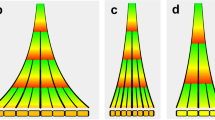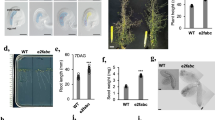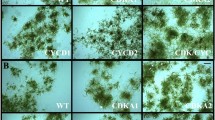Abstract
Plant genome projects have revealed that both the cell-cycle components and the overall cell-cycle architecture are highly evolutionarily conserved. In addition to the temporal and spatial regulation of cell-cycle progression in individual cells, multicellularity has imposed extra layers of complexity that impinge on the balance of cell proliferation and growth, differentiation and organogenesis. In contrast to animals, organogenesis in plants is a postembryonic and continuous process. Differentiated plant cells can revert to a pluripotent state, proliferate and transdifferentiate. This unique potential is strikingly illustrated by the ability of certain cells to produce a mass of undifferentiated cells or a fully totipotent embryo, which can regenerate mature plants. Conversely, plant cells are highly resistant to oncogenic transformation. This review discusses the role that cell-cycle regulators may have at the interface between cell division and differentiation, and in the context of the high plasticity of plant cells.
This is a preview of subscription content, access via your institution
Access options
Subscribe to this journal
Receive 12 print issues and online access
$209.00 per year
only $17.42 per issue
Buy this article
- Purchase on Springer Link
- Instant access to full article PDF
Prices may be subject to local taxes which are calculated during checkout



Similar content being viewed by others
References
Arabidopsis Genome Initiative. Analysis of the genome sequence of the flowering plant Arabidopsis thaliana. Nature 408, 796–815 (2000).
Vandepoele, K et al. Genome-wide analysis of core cell cycle genes in Arabidopsis. Plant Cell 14, 903–916 (2002).
Baldauf, S. L. The deep roots of eukaryotes. Science 300, 1703–1706 (2003).
Weigel, D. & Jürgens, G. Stem cells that make stems. Nature 415, 751–754 (2002).
Gutierrez, C., Ramirez-Parra, E., Castellano, M. M. & del Pozo, J. C. G(1) to S transition: more than a cell cycle engine switch. Curr. Opin. Plant Biol. 5, 480–486 (2002).
Dewitte, W. & Murray, J. A. H. The plant cell cycle. Annu. Rev. Plant. Biol. 54, 235–264 (2003).
Inzé, D. Green light for the cell cycle. EMBO J. 24, 657–662 (2005).
Boudolf, V. et al. The plant-specific cyclin-dependent kinase CDKB1;1 and transcription factor E2Fa-DPa control the balance of mitotically dividing and endoreduplicating cells in Arabidopsis. Plant Cell 16, 2683–2692 (2004).
Boudolf, V. et al. B1-type cyclin-dependent kinases are essential for the formation of stomatal complexes in Arabidopsis thaliana. Plant Cell 16, 945–955 (2004).
Wang, W. & Chen, Z. HUA ENHANCER3 reveals a role for a cyclin-dependent protein kinase in the specification of floral organ identity in Arabidopsis. Development 131, 3147–3156 (2004).
Ormenese, S. et al. Analysis of the spatial expression pattern of seven Kip related proteins (KRPs) in the shoot apex of Arabidopsis thaliana. Ann. Bot. 93, 575–580 (2004).
Wang, H., Zhou, Y., Gilmer, S., Whitwill, S. & Fowke, L. C. Expression of the plant cyclin-dependent kinase inhibitor ICK1 affects cell division, plant growth and morphology. Plant J. 24, 613–623 (2000).
De Veylder, L. et al. Functional analysis of cyclin-dependent kinase inhibitors of Arabidopsis. Plant Cell 13, 1653–1658 (2001).
Zhou, Y., Wang, H., Gilmer, S., Whitwill, S. & Fowke, L. C. Effects of co-expressing the plant CDK inhibitor ICK1 and D-type cyclin genes on plant growth, cell size and ploidyin Arabidopsis thaliana. Planta 216, 604–613 (2003).
De Veylder, L., Beemster, G. T., Beeckman, T. & Inzé, D. CKS1At overexpression in Arabidopsis thaliana inhibits growth by reducing meristem size and inhibiting cell-cycle progression. Plant J. 25, 617–626 (2001).
Hülskamp, M., Schnittger, A. & Folkers, U. Pattern formation and cell differentiation: trichomes in Arabidopsis as a genetic model system. Int. Rev. Cytol. 186, 147–178 (1999).
Schnittger, A., Weinl, C., Bouyer, D., Schobinger, U. & Hulskamp, M. Misexpression of the cyclin-dependent kinase inhibitor ICK1/KRP1 in single-celled Arabidopsis trichomes reduces endoreduplication and cell size and induces cell death. Plant Cell 15, 303–315 (2003).
Wang, G. et al. Genome-wide analysis of the cyclin family in Arabidopsis and comparative phylogenetic analysis of plant cyclin-like proteins Plant Physiol. 135, 1084–1099 (2004).
Cockcroft, C. E., den Boer, B. G., Healy, J. M. & Murray, J. A. Cyclin D control of growth rate in plants. Nature 405, 575–579 (2000).
Dewitte, W. et al. Altered cell cycle distribution, hyperplasia, and inhibited differentiation in Arabidopsis caused by the D-type cyclinCYCD3. Plant Cell 15, 79–92 (2003).
Tantikanjana, T. et al. Control of axillary bud initiation and shoot architecture in Arabidopsis through the SUPERSHOOT gene. Genes Dev. 15, 1577–1588 (2001).
Yu, Y., Steinmetz, A., Meyer, D., Brown, S. & Shen, W. H. The tobacco A-type cyclin, Nicta;CYCA3;2, at the nexus of cell division and differentiation. Plant Cell 15, 2763–2777 (2003).
Schnittger, A. et al. Ectopic D-type cyclin expression induces not only DNA replication but also cell division in Arabidopsis trichomes. Proc. Natl Acad. Sci. USA 99, 6410–6415 (2002).
Walker, J. D., Oppenheimer, D. G., Concienne, J. & Larkin, J. C. SIAMESE, a gene controlling the endoreduplication cell cycle in Arabidopsis thaliana trichomes. Development 127, 3931–3940 (2000).
Tong, W & Pollard, J. W. Genetic evidence for the interactions of cyclin D1 and p27Kip1 in mice. Mol. Cell. Biol. 21, 1319–1328 (2001).
Soni, R., Carmichel, J. P., Shah, Z. H. & Murray, J. A. H. A family of cyclin D homologs from plants differentially controlled by growth regulators and containing the conserved retinoblastoma protein interaction motif. Plant Cell 7, 85–103 (1995).
Xie, Q., Suarez-Lopez, P. & Gutierrez, C. Identification and analysis of a retinoblastoma binding motif in the replication protein of a plant DNA virus: requirement for efficient viral DNA replication. EMBO J. 14, 4073–4082 (1995).
Grafi, G. et al. A maize cDNA encoding a member of the retinoblastoma protein family: involvement in endoreduplication. Proc. Natl Acad. Sci. USA 93, 8962–8967 (1996).
Xie, Q., Sanz-Burgos, A. P., Hannon, G. J. & Gutierrez, C. Plant cells contain a novel member of the retinoblastoma family of growth regulatory proteins. EMBO J. 15, 4900–4908 (1996).
Boniotti, M. B. & Gutierrez, C. A cell-cycle regulated kinase activity phsphorylates plant retinoblastoma protein and contains, in Arabidopsis, a CDKA/cyclin D complex. Plant J. 28, 341–350 (2001).
Nakagami, H., Kawamura, K., Sugisaka, K., Sekine, M. & Shinmyo, A. Phosphorylation of retinoblastoma-related protein by the cyclin D/cyclin-dependent kinase complex is activated at the G1/S-phase transition in tobacco. Plant Cell 14, 1847–1857 (2002).
Yadegari, R. & Drews, G. N. Female gametophyte development. Plant Cell 16, S133–S141 (2004).
Ebel, C., Mariconti, L. & Gruissem, W. Plant retinoblastoma homologues control nuclear proliferation in the female gametophyte. Nature 429, 776–780 (2004).
Grafi, G. & Larkins, B. A. Endoreduplication in maize endosperm: involvement of M-phase promoting factor inhibition and induction of S-phase-related kinases. Science 269, 1262–1264 (1995).
de Jager, S. M., Menges, M., Bauer, U. M. & Murray, J. A. Arabidopsis E2F1 binds a sequence present in the promoter of S-phase-regulated gene AtCDC6 and is a member of a multigene family with differential activities. Plant Mol. Biol. 47, 555–568 (2001).
Mariconti, L. et al. The E2F family of transcription factors from Arabidopsis thaliana. Novel and conserved components of the retinoblastoma/E2F pathway in plants. J. Biol. Chem. 277, 9911–9919 (2002).
Kosugi, S. & Ohashi, Y. E2Ls, E2F-like repressors of Arabidopsis that bind to E2F sites in a monomeric form. J. Biol. Chem. 277, 16553–16558 (2002).
Vlieghe, K. et al. Microarray analysis of E2Fa-DPa-overexpressing plants uncovers a cross-talking genetic network between DNA replication and nitrogen assimilation. J. Cell Sci. 116, 4249–4259 (2003).
Ramirez-Parra, E., Fründt, C. & Gutierrez, C. A genome-wide identification of E2F regulated genes in Arabidopsis. Plant J. 33, 801–811 (2003).
De Veylder, L. et al. Control of proliferation, endoreduplication and differentiation by the Arabidopsis E2Fa-DPa transcription factor. EMBO J. 21, 1360–1368 (2002).
Kosugi, S. & Ohashi, Y. Interaction of the Arabidopsis E2F and DP proteins confers their concomitant nuclear translocation and transactivation. Plant Physiol. 128, 833–843 (2002).
Del Pozo, J. C., Boniotti, M. B. & Gutierrez, C. Arabidopsis E2Fc functions in cell division and is degraded by the ubiquitin-SCF (AtSKP2) pathway in response to light. Plant Cell 14, 3057–3071 (2002).
Ramirez-Parra, E., Lopez-Matas, M. A., Fründt, C. & Gutierrez, C. Role of an atypical E2F transcription factor in the control of Arabidopsis cell growth and differentiation. Plant Cell 16, 2350–2363 (2004).
Edgar, B. A. & Orr-Weaver, T. L. Endoreplication cell cycles: more or less. Cell 105, 297–306 (2002).
Kondorosi, E., Roudier, F. & Gendreau, E. Plant cell-size control: growing by ploidy? Curr. Opin. Plant Biol. 3, 488–492 (2000).
Capron, A., Okresz, L. & Genschik, P. First glance at the plant APC/C, a highly conserved ubiquitin-protein ligase. Trends Plant Sci. 8, 83–89 (2003).
Cebolla, A. et al. The mitotic inhibitor ccs52 is required for endoreduplication and ploidy-dependent cell enlargement in plants. EMBO J. 16, 4476–4484 (1999).
Schnittger, A., Schobinger, U., Stierhof, Y. D. & Hulskamp, M. Ectopic B-type cyclin expression induces mitotic cycles in endoreduplicating Arabidopsis trichomes. Curr. Biol. 12, 415–420 (2002).
Capron, A. et al. The Arabidopsis anaphase-promoting complex or cyclosome: molecular and genetic characterization of the APC2 subunit. Plant Cell 15, 2370–2382 (2003).
Kwee, H. S. & Sundaresan, V. The NOMEGA gene required for female gametophyte development encodes the putative APC6/CDC16 component of the Anaphase Promoting Complex in Arabidopsis. Plant J. 36, 853–866 (2003).
Blilou, I. et al. The Arabidopsis HOBBIT gene encodes a CDC27 homolog that links the plant cell cycle to progression of cell differentiation. Genes Dev. 16, 2566–2575 (2002).
Autran, D. et al. Cell numbers and leaf development in Arabidopsis: a functional analysis of the STRUWWELPETER gene. EMBO J. 21, 6036–6039 (2002).
Sugimoto-Shirazu, K., Stacey, N. J., Corsar, J., Roberts, K. & McCann, M. C. DNA topoisomerase VI is essential for endoreduplication in Arabidopsis. Curr. Biol. 12, 1782–1786 (2002).
Hartung, F. et al. An archaebacterial topoisomerase homolog not present in other eukaryotes is indispensable for cell proliferation of plants. Curr. Biol. 12, 1787–1791 (2002).
Bell, S. P. & Dutta, A. DNA replication in eukaryotic cells. Annu. Rev. Biochem. 71, 333–374 (2002).
Castellano, M. M., del Pozo, J. C., Ramirez-Parra, E., Brown, S. & Gutierrez, C. Expression and stability of Arabidopsis CDC6 are associated with endoreplication. Plant Cell 13, 2671–2686 (2001).
Castellano, M. M., Boniotti, M. B., Caro, E., Schnittger, A. & Gutierrez, C. DNA replication licensing affects cell proliferation or endoreplication in a cell type-specific manner. Plant Cell 16, 2380–2393 (2004).
Del Bene, F., Tessmar-Raible, K. & Wittbrodt, J. Direct interaction of geminin and Six3 in eye development. Nature 427, 745–749 (2004).
McCormick, S. Control of male gametophyte development. Plant Cell 16, S142–S153 (2004).
Holding, D. R. & Springer, P. S. The Arabidopsis gene PROLIFERA is required for proper cytokinesis during seed development. Planta 214, 373–382 (2002).
Stevens, R. et al. A CDC45 homolog in Arabidopsis is essential for meiosis, as shown by RNA interference-induced gene silencing. Plant Cell 16, 99–113 (2004).
Collinge, M. A., Spillane, C., Kohler, C., Gheyselinck, J. & Grossniklaus, U. Genetic interaction of an origin recognition complex subunit and the Polycomb group gene MEDEA during seed development. Plant Cell 16, 1035–1046 (2004).
Köhler, C. et al. The Polycomb-group protein MEDEA regulates seed development by controlling expression of the MADS-box gene PHERES1. Genes Dev. 17, 1540–1553 (2003).
Liu, C. M. et al. Condensin and cohesin knockouts in Arabidopsis exhibit a titan seed phenotype. Plant J. 29, 405–415 (2002).
Siddiqui, N. U., Stronghill, P. E., Dengler, R. E., Hasenkampf, C. A. & Riggs, C. D. Mutations in Arabidopsis condensin genes disrupt embryogenesis, meristem organization and segregation of homologous chromosomes during meiosis. Development 130, 3283–3295 (2003).
Casimiro, I. et al. Dissecting Arabidopsis lateral root development. Trends Plant Sci. 8, 165–171 (2003).
Himanen, K. et al. Auxin-mediated cell cycle activation during early lateral root initiation. Plant Cell 14, 2339–2351 (2002).
Himanen, K. et al. Transcript profiling of early lateral root initiation. Proc. Natl Acad. Sci. USA 101, 5146–5151 (2004).
Zuo, J., Niu, Q. W., Frugis, G. & Chua, N. H. The WUSCHEL gene promotes vegetative-to-embryonic transition in Arabidopsis. Plant J. 30, 349–359 (2002).
Gallois, J. L., Nora, F. R., Mizukami, Y. & Sablowski, R. WUSCHEL induces shoot stem cell activity and developmental plasticity in the root meristem. Genes Dev. 18, 375–380 (2004).
Suzuki, T. et al. A novel Arabidopsis gene TONSOKU is required for proper cell arrangement in root and shoot apical meristems. Plant J. 38, 673–684 (2004).
Harrar, Y., Bellec, Y., Bellini, C. & Faure, J. D. Hormonal control of cell proliferation requires PASTICCINO genes. Plant Physiol. 132, 1217–1227 (2003).
Sieberer, T., Hauser, M. T., Seifert, G. J. & Luschnig, C. PROPORZ1, a putative Arabidopsis transcriptional adaptor protein, mediates auxin and cytokinin signals in the control of cell proliferation. Curr. Biol. 13, 837–842 (2003).
Zhao, J. et al. Two phases of chromatin decondensation during dedifferentiation of plant cells. Distinction between competence for cell fate switch and a commitment for S-phase. J. Biol. Chem. 276, 22772–22778 (2001).
Ikeda-Iwai, M., Umehara, M., Satoh, S. & Kamada, H. Stress-induced somatic embryogenesis in vegetative tissues of Arabidopsis thaliana. Plant J. 34, 107–114 (2003).
Lotan, T. et al. Arabidopsis LEAFY COTYLEDON1 is sufficient to induce embryo development in vegetative cells. Cell 93, 1195–1205 (1998).
Stone, S. L. et al. LEAFY COTYLEDON2 encodes a B3 domain transcription factor that induces embryo development. Proc. Natl Acad. Sci. USA 98, 11806–11811 (2001).
Dean Rider, S. Jr et al. Coordinate repression of regulators of embryonic identity by PICKLE during germination in Arabidopsis. Plant J. 35, 33–43 (2003).
Kaya, H. et al. FASCIATA genes for chromatin assembly factor-1 in Arabidopsis maintain the cellular organization of apical meristems. Cell 104, 131–142 (2001).
Ach, R. A., Taranto, P. & Gruissem, W. A conserved family of WD-40 proteins binds to the retinoblastoma protein in both plants and animals. Plant Cell 9, 1595–1606 (1997).
Bracken, A. P. et al. EZH2 is downstream of the pRB-E2F pathway, essential for proliferation and amplified in cancer. EMBO J. 22, 5323–5335 (2003).
Riha, K., McKnight, T. D., Griffing, L. R. & Shippen, D. E. Living with genome instability: plant responses to telomere dysfunction. Science 291, 1797–1800 (2001).
Garcia, V. et al. AtATM is essential for meiosis and the somatic response to DNA damage in plants. Plant Cell 15, 119–132 (2003).
Culligan, K., Tissier, A. & Britt, A. ATR regulates a G2-phase cell-cycle checkpoint in Arabidopsis thaliana. Plant Cell 16, 1091–1104 (2004).
Lafarge, S & Montane, M. H. Characterization of Arabidopsis thaliana ortholog of the human breast cancer susceptibility gene 1: AtBRCA1, strongly induced by gamma rays. Nucleic Acids Res. 31, 1148–1155 (2003).
Ehsan, H., Reichheld, J. P., Durfee, T. & Roe, J. L. TOUSLED kinase activity oscillates during the cell cycle and interacts with chromatin regulators. Plant Physiol. 134, 1488–1499 (2004).
Gutierrez, C. DNA replication and cell cycle in plants: learning from geminiviruses. EMBO J. 19, 792–799 (2000).
Beemster, G. T., Fiorani, F. & Inzé, D. Cell cycle: the key to plant growth control? Trends Plant Sci. 8, 154–158 (2003).
Boutilier, K. et al. Ectopic expression of BABY BOOM triggers a conversion from vegetative to embryonic growth. Plant Cell 14, 1737–1749 (2002).
Ausín, I., Alonso-Blanco, C., Jarillo, J. A., Ruiz-García, L. & Martínez-Zapater, J. M. Regulation of flowering time by FVE, a retinoblastoma-associated protein. Nature Genet. 36, 162–166 (2004).
He, Y. & Amasino, R. M. Role of chromatin modifications in flowering-time control. Trends Plant Sci. 10, 30–35 (2005).
Palatnik, J., Allens, E., Wu, X., Schommer, C., Schwab, R., Carrington, J. C. & Weigel, D. Control of leaf morphogenesis by microRNAs. Nature 425, 257–263 (2003).
Vlieghe, K. et al. The DP-E2F-like gene DEL1 controls the endocycle in Arabidopsis thaliana. Curr. Biol. 15, 59–63 (2005).
Acknowledgements
My apologies to colleagues whose work has not been cited here due to space restrictions. Thanks to many colleagues for discussions and to M. Serrano, M. A. Blasco, E. Martinez-Salas, J. A. Tercero and members of my laboratory for discussions and comments on the manuscript. Our work is supported by grants BMC2003-2131 (MCyT), MCFI-2001-00509 (EU) and 07B/053/2002 (CAM), and by an institutional grant from Fundación Ramón Areces.
Author information
Authors and Affiliations
Ethics declarations
Competing interests
The author declares no competing financial interests.
Rights and permissions
About this article
Cite this article
Gutierrez, C. Coupling cell proliferation and development in plants. Nat Cell Biol 7, 535–541 (2005). https://doi.org/10.1038/ncb0605-535
Issue Date:
DOI: https://doi.org/10.1038/ncb0605-535
This article is cited by
-
Identification and fine mapping of a stigma exsertion mutant gene (Bolsem) in ornamental kale (Brassica oleracea var. acephala)
Molecular Breeding (2019)
-
Proto-oncogenes in a eukaryotic unicellular organism play essential roles in plasmodial growth in host cells
BMC Genomics (2018)
-
Arabidopsis NUCLEOSTEMIN-LIKE 1 (NSN1) regulates cell cycling potentially by cooperating with nucleosome assembly protein AtNAP1;1
BMC Plant Biology (2018)
-
Embryonic epigenetic reprogramming by a pioneer transcription factor in plants
Nature (2017)
-
Overexpression of CYCD1;2 in activation-tagged Populus tremula x Populus alba results in decreased cell size and altered leaf morphology
Tree Genetics & Genomes (2015)



